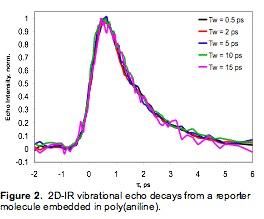

46628-G6
Structural Dynamics in Conducting Polymer Systems Probed with In-Situ Electrochemical Two-dimensional Infrared Spectroscopy
Minneapolis,
MN 55455-0431
II. Conducting Polymer Dynamics: In the early work of this project, we endeavored to measure 2D-IR signals from nitrile containing poly(aniline) (PANI) thin films with little to no success. The underlying limitation to that approach seemed to be the absorbing strength of the CN oscillator. Also an issue with that approach was that the functionalized PANI films had little to no conductivity, which would make many of the goals of this project unobtainable. We modified our approach by embedding IR-active chromophores as dynamics reporters into several different polymer films. Figure 2 shows the 2D-IR vibrational echo decay data collected from the reporting species embedded in a semiconducting PANI thin film. The decay times are clearly longer than those of the solution-phase probe (Figure 1), which is intuitive since the chemical environment should fluctuate faster in solution. We obtained the same datasets for CN-PPV, an n-type semiconducting polymer film, and note that the dynamics reported by the embedded molecule are noticeably different. Of particular interest, both polymers show structure motions on the timescales of tens of fs that are not resolved by our instrument, but the CN-PPV also shows dynamics on the tens of ps timescale. We have fit the data for both polymers to quantify these differences, and have determined that the CN-PPV has a unique structural dynamic component with a time constant of 44 ps that is absent in the PANI dynamics. Building on these early successes, we have approached this project as a means to catalogue the timescales of motion that are present and unique in a range of conducting and semiconducting polymers. This effort is ongoing during the second year of funding.
In the process of measuring structural dynamics in various polymers, we attempted to embed our reporter into regioregular poly(3-hexylthiophene) (P3HT), a semicrystalline semiconducting polymer with applications in photovoltaics and molecular electronics. We were surprised to find that the polymer and the reporter molecule can be controllably mixed and phase segregated. What is particularly intriguing about our observations of this system is that it appears that we can measure the structural dynamics for different domains and sub-environments within the same polymer. By spectrally resolving the 2D-IR echo signals, we are able to selectively measure the decay curves that correspond to the blended and segregated samples. We currently have a manuscript in progress for this system that we hope to submit before the end of the year. Preliminary results with iodine doping indicate that we should be able to perform in-situ conductivity and dynamics measurements with this sample, which is another ongoing effort for the project in the second year of funding.

